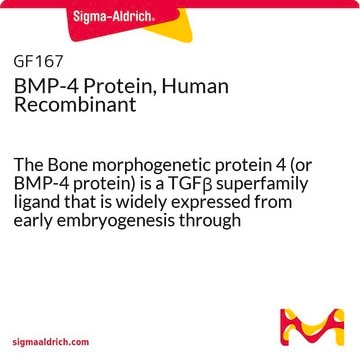H4916
Bone Morphogenetic Protein 4 human
BMP-4, recombinant, expressed in HEK 293 cells, HumanKine®, suitable for cell culture
Synonym(s):
BMP-4
About This Item
Recommended Products
biological source
human
Quality Level
recombinant
expressed in HEK 293 cells
Assay
>95% (SDS-PAGE)
form
lyophilized powder
potency
≤10 ng/mL EC50
quality
endotoxin tested
mol wt
dimer 34 kDa (glycosylated)
packaging
pkg of 10 μg
pkg of 100 μg
pkg of 1000 μg
storage condition
avoid repeated freeze/thaw cycles
technique(s)
cell culture | mammalian: suitable
impurities
<1 EU/μg Endotoxin level
UniProt accession no.
storage temp.
−20°C
Gene Information
human ... BMP4(652)
Looking for similar products? Visit Product Comparison Guide
General description
Application
Biochem/physiol Actions
Cellular responses to BMP-4 are mediated by the formation of hetero-oligomeric complexes of type I and type II serine/threonine kinase receptors, which play significant roles in BMP binding and signaling. Two BMP type I receptors and one BMP type II receptor have been identified. Both BMP type I receptors bind BMP-4 with high-affinity in the absence of BMP receptor type II.
Physical form
Preparation Note
Analysis Note
Legal Information
comparable product
inhibitor
Storage Class Code
11 - Combustible Solids
WGK
WGK 3
Flash Point(F)
Not applicable
Flash Point(C)
Not applicable
Certificates of Analysis (COA)
Search for Certificates of Analysis (COA) by entering the products Lot/Batch Number. Lot and Batch Numbers can be found on a product’s label following the words ‘Lot’ or ‘Batch’.
Already Own This Product?
Find documentation for the products that you have recently purchased in the Document Library.
Customers Also Viewed
Our team of scientists has experience in all areas of research including Life Science, Material Science, Chemical Synthesis, Chromatography, Analytical and many others.
Contact Technical Service













